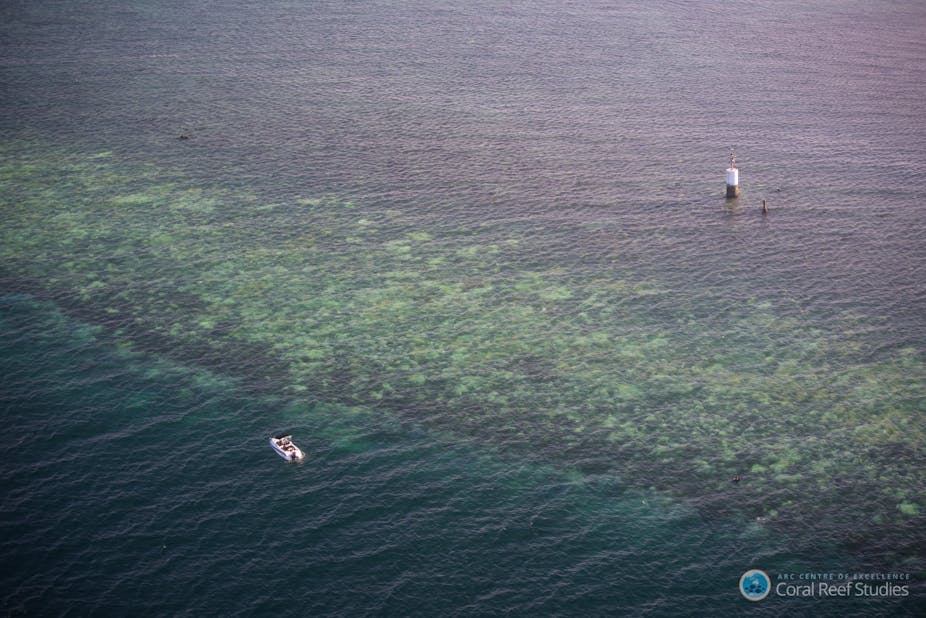Large sections of the Great Barrier Reef, the Earth’s largest living structure, are dying before our eyes. Sustained high sea temperatures have stressed the corals to the point where they expel the brightly coloured algae that live within their tissues. This process is aptly named bleaching as it removes all pigment and exposes the shocking white calcium skeleton of the reef structures.
The coral can survive in this state for up to a few weeks. Thereafter, if temperatures do not decrease then they will die.
The Great Barrier Reef has experienced bleaching events twice before. The first, in 1998, was bad enough, with 50% of the reef affected. 2002 was even worse with 60% of the reef bleached. Recent aerial surveys of the northern 1000km of the reef evaluated 500 different sections – 95% were bleached.
The full impact that such bleaching is having will not be known until biologists directly observe the corals in the water. Estimates coming back from initial monitoring show that on some reefs more than half of the coral has already died.
Given the record-shattering temperatures over the past year, coral researchers were preparing themselves for another mass bleaching. But the scale of this event has left some researchers stunned. Or angry. Returning from five weeks investigating the reefs, Jodie Rummer, a biologist at the ARC Centre of Excellence for Coral Reef Studies said:
“I witnessed a sight underwater that no marine biologist, and no person with a love and appreciation for the natural world for that matter, wants to see”.
Many are asking the simple question – why is this happening? First, we need to stress that there was not a single coral bleaching event on the Great Barrier Reef in the 400 years prior to 1998. While the current extreme El Niño is playing a part in this latest episode of coral destruction, the underlying driver is increasing global temperatures as a consequence of human-made climate change.
Why corals need their colour
Coral polyps and their colourful zooxanthellae algae have a tightly coupled relationship, where each aids the other.
The algae are autotrophic photosynthesisers, which means they make their own food by using sunlight to split carbon dioxide molecules and form sugars. Coral polyps are much more complex heterotrophs – they use fine-meshed sieves to sweep up suspended organic matter from sea water.

For the algae, a coral reef represents the perfect place to live. There, they are safe and secure within a strong structure, near the surface and so able to receive large amounts of energy from the sun along with coral polyp waste, which helps promote photosynthesis. In fact photosynthesis is so productive that the algae produce more food than they can consume. This surplus is greedily gobbled up by the coral polyps. It’s a win-win situation – what biologists call a mutualistic symbiosis.
However, just like any biological process there are environmental limits. Higher temperatures along with very bright sunshine can impact both coral polyps and their algae and their relationship breaks down, leading to the expulsion of the algae and bleached coral.
Bleaching can also be driven by pollution, particularly agricultural run-off and sedimentation from activities such as dredging. These two factors threaten the more southern portions of the Great Barrier Reef which at least so far have dodged some of the very worst bleaching as sea temperatures have been lower. The northern stretch of the reef is more remote and better protected from human impacts, but it has borne the brunt of extreme temperatures.
Our response…
Given that scientists have been warning about a significant bleaching episode for some time now, one may have hoped for a coordinated response to this predictable disaster. There have indeed been related developments.
While biologists were in the air and under the water scrambling to understand the severity of this latest bleaching event, the Queensland Government approved mining leases for the A$21.7 billion Carmichael coal mine and associated new rail line in the Galilee Basin. If all of this coal is extracted and burnt, some 4.6 billion tons of carbon dioxide will be released into the Earth’s atmosphere.
Given climate change’s obvious impact on the Great Barrier Reef, some scientists have pointed out the fundamental contradiction in a government stating that it is both committed to protecting the reef and developing these new coal mines.

As if adding insult to injury, the vast majority of the Galilee Basin coal will be shipped out of the deep water port of Abbot Point which is within the Great Barrier Reef UNESCO world heritage site. Those shipping the coal will be able to wave goodbye to the reef in more than one way as they transport it to power stations in India, China and Japan where it will be burnt and so contribute to further warming and further bleaching.
At times like this, it’s hard not to anthropomorphise – to see the Great Barrier Reef and other coral reefs around the world turning white not due to bleaching, but in shock at our sustained attack on the natural world. The events unfolding off the coast of north eastern Australia are dramatic, but are also just the latest manifestation of the mass extinction event humans have initiated.
This not only drains the colour from the Earths’ most magnificent aquatic ecosystems, but robs us of biological beauty across the world. We will all lead diminished lives because of it.

